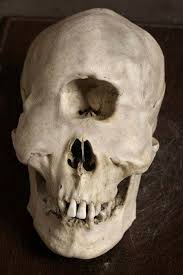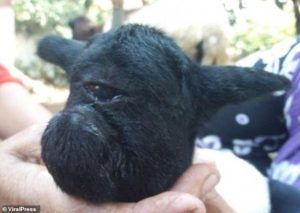Cyclopia (alobar holoprosencephaly) is a rare and lethal complex human malformation, resulting from incomplete cleavage of prosencephalon into right and left hemispheres occurring between the 18th and the 28th day of gestation. Holoprosencephaly occurs in 1/16,000 live births, and 1/250 during embryogenesis. Approximately 1.05 in 100,000 births are identified as infants with cyclopia, including stillbirths. Cyclopia typically presents with a median single eye or a partially divided eye in a single orbit, absent nose, and a proboscis above the eye. Extracranial malformations described in stillbirths with cyclopia include polydactyl, renal dysplasia, and an omphalocele. The etiology of this rare syndrome, which is incompatible with life, is still largely unknown. Most cases are sporadic. Heterogeneous risk factors have been implicated as possible causes.
Although cyclopia is rare, several cyclopic human babies are preserved in medical museums (e.g. The Vrolik Museum, Amsterdam).
Cells in the mesoderm layer at the midline of the embryo secrete signals that establish midline identity in the overlying neural plate. Among these signals are members of the hedgehog (Hh) family of proteins, which can induce a variety of cells, including the neural midline. This region gives rise to the ventral brain of the embryo, and the floorplate and motor neurons in the spinal cord. Mouse embryos with mutations in the gene that encodes Sonic hedgehog (Shh) do not develop midline structures of the neural plate, leading, at worst, to profound cyclopia. A single, medial eye is located above a nose containing a single nostril. But although Shh is necessary for specification of the neural plate, other results indicate that it may not be enough. Cloning of the genes responsible for two cyclopic zebrafish mutant phenotypes now suggests that members of the transforming growth factor-β (TGF-β) family may also be involved in these processes.
Some extreme cases of cyclopia have been documented in farm animals (horses, sheep, pigs, and sometimes chickens). In such cases, the nose and mouth fail to form, or the nose grows from the roof of the mouth obstructing airflow, resulting in suffocation shortly after birth.
Genetic problems or toxins can cause problems in the embryonic forebrain-dividing process. One highly teratogenic alkaloid toxin that can cause cyclopia is cyclopamine or 2-deoxyjervine, found in the plant Veratrum californicum (also known as corn lily or false hellebore). The mistake of ingesting Veratrum californicum while pregnant is often because hellebore, a plant with which it is easily confused, is recommended as a natural treatment for vomiting, cramps, and poor circulation, three conditions that are quite common in pregnant women. Cyclopia can occur in the womb when certain proteins are inappropriately expressed and causes the brain to stay whole instead of forming into two distinct hemispheres, which also means one optic lobe and one olfactory lobe resulting in one eye.
SHH (Sonic Hedgehog Gene Regulator, named after the effects a mutation in the gene had on the forming embryo of fruit flies studied by scientists; a spiky appearance under a microscope, similar to that of its video game character namesake) is involved in the separation of the single eye field into two bilateral fields. Although not proven, it is thought that SHH emitted from the prechordal plate suppresses Pax6 which causes the eye field to divide into two. If the shh gene is mutated, the result is cyclopia, a single eye in the center of the face (Gilbert, 2000).


